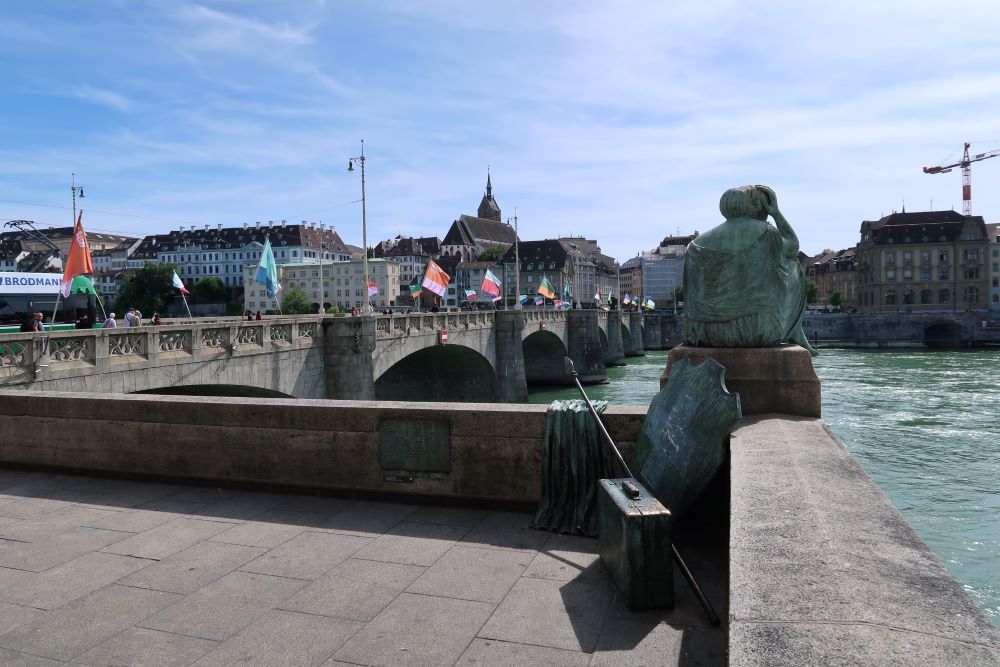Helvetia, the Rhine and Basel
15 July 2022
The Rhine flows out of Switzerland at Basel. It continues its journey to the North Sea as a (border) river through Germany, France and the Netherlands. At Spijk and Millingen, it enters the Netherlands and is called the Waal. The Waal splits into several rivers, the famous Dutch river landscape.

De Waal and Spiegelwaal at Nijmegen, Photo: Wikipedia/Damatrix
The Waal is the mainstream. Nijmegen is the first large (ancient Roman) city on its way. However, the Waal then splits into various other rivers. One part becomes the Upper Merwede and the New Maas near Rotterdam.
The Oude Maas joins the Nieuwe Maas at Rotterdam to form the Nieuwe Waterweg, which flows into the North Sea. This complex of waterways is the basis of the port of Rotterdam and its economic activities.
Another part of the Waal, after joining the Bergsche Maas, flows into the Hollands Diep, the Haringvliet.
In addition to these two main streams, the Waal has other branches. After Millingen, the Waal splits into the IJssel and the Nederrijn. The IJssel bends to the north and ends in the IJsselmeer.
On its way, it meanders through the forelands of Gelderland and Overijssel, passing beautiful medieval Hanseatic towns (among others, Zutphen, Deventer, Zwolle and Kampen). The Nederrijn is called the Lek halfway. It flows into the Nieuwe Maas and the North Sea.

The IJssel River. Photo: www.Hanzesteden.nl
The Nederrijn (known from a Bridge too Far, Arnhem, September 1944, Operation Market Garden) has a branch called the Kromme Rijn, Leidse Rijn and the Oude Rijn, which flows into the North Sea via Utrecht and Katwijk. The Amsterdam-Rhine Canal (dug in the mid-19th century) connects Amsterdam and the North Sea (via the North Sea Canal) with the Rhine.
The Scheldt-Rhine Canal connects cities like Dordrecht with the Westerschelde via the Hollandsdiep, Volkerak and Oosterschelde.
Helvetia has long been the image of Swiss coins. She got tired of it and went on a journey to get to know her Switzerland. After a long journey through valleys, mountains, villages and cities, she reached Basel.

The Rhine near Augst (Canton Basel-Landschaft). Photo: TES
She decided to stay in Basel, thinking and musing about the Rhine and what lies in store for her on her journey. Helvetia has been sitting on the Mittlere brücke in Basel for over forty years. She may be musing on Hendrik Marsman’s (1899-1940) famous poem Thinking of Holland.
Helvetia, a sculpture by Bettina Eichin (1942), was made in 1980. She called it Seated Helvetia (Sitzende Helvetia), a self-confident woman who thinks across borders and looks into the world.
The artist wrote the following explanation:
“…eines Tages verlässt Helvetia ein Zweifrankenstück, mischt sich unters Volk und unternimmt eine längere Reise. Along the way she also comes to Basel. Nach einem anstrengenden Gang durch die Stadt legt sie Mantel, Schild, Speer und Koffer ab und ruht sich auf einem Brückenpfeiler der Mittleren Rheinbrücke aus und blickt nachdenklich rheinabwärts”.


